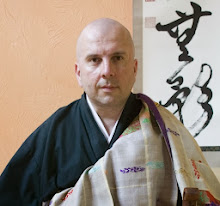
I am now in Japan. In Kyoto. Won't be working on technical aspects of kesa sewing for a while. I am just busy doing very little, takuhatsu, visiting temples and sleeping. A good and quiet time. I thought you would like this old Soto kesa circa 1750 that I will bring back to the West ( If I ever come back). I was fortunate to find it through Yoshiko, a very kind art dealer. I haven't manage to find a fukudenkai yet. Love to all.


6 Comments:
Pierre,
can you give me some tips on how to make a very light and thin robe? i live in the hot and steamy tropics. Also, my style is leaning toward that of the fully wrapped but nearly naked underneath bhikshu, if you know what i mean. however if the cloth is too there is the problem of it not being strong enough, on the one hand, and of being too transparent, on the other. is it possible to overlap all the inner panels? this would make some portions of the robe double layered. and then the same would be the case on the outer border, which is normal done anyway.
thanks,
sritantra
Dear Sritantra,
Thank you for trusting my very limited knowledge. It must be something to have to put up with so much heat...I believe, but I think the use of it is prohibited in your tradition, that silk is the best option to combine resistance and lightness. I also know that if you can pay the price, some cottons designed in India are known to be very reistant too. It is definitely possible to overlap all the inner panels, in order to do so you may either sew a huge piece of material on the back of the kesa or sew one patch at a time at the back of each panel. At least, this method is seen in the japanese tradition of kesa making.
I hope that i answered your question.
Buddha bless
Tetsuten
Pierre,
Thank you for your kind response. Yes, I believe that Indian dhoti (fine cotton) could work if the numerous panels are overlaid 5 or 6 cm. In fact, the panel corners would be three-ply. But dhoti only comes in white; usually bleached, but also unbleached. In any case it would have to be dyed. So I'm thinking, when to dye it? Regarding Gautama's sublime nakedness, the fabric of this history has definitely had its revealing SE Asian episodes. See Buddha with gossamer robe http://tinyurl.com/ezotd
sritantra
Dear Sritantra,
Usually, we dye the fabric before sewing as one piece, one panel. Then we cut and eventually sew. The question is how to dye it? With what? You can invistigate and start to relate to minerals and vegetals around you, what is traditionnaly used where you live to dye fabric. You want a yellowish-safran colour I imagine, ask with your senses, listen, open your eyes. Ask people, sit with them. The teaching of the Buddha's robe starts there in questionning this reality than nobody can exhaust.
Love.
Tetsuten
One more thing to say, if I may, The function of the robe is many: protecting ( weather conditions, animal bites ), revealing (transparency as a way into openess), hiding (the sexual dimension lived and experienced as manifestation of the dual and instinctual) transforming ( the human body returns to Dharmakaya ) and,at the same time, it is beyond all these aspects.
i really like the gossamer robe, Yes. Wonderful. that's the idea...in the tradition, it is said that Buddha's kasaya had the same colour as his skin. What does it mean? I don't know. I really don't know.
It sounds like an allusion to nakedness.
Sritantra / Malaysia
Post a Comment
<< Home